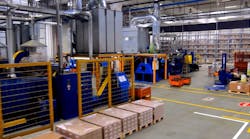Floor marking is an affordable and versatile solution for improving all aspects of the workflow. It provides key information that may have been forgotten or unnoticed to people at the exact location where they need it, making a facility safer and more efficient. Here are four significant ways floor marking improves operations in any facility:
1. Addresses Facility-specific Needs
Customize your floor marking system to bring attention to site-specific hazards and procedures. Since no two facilities are alike, floor marking is a useful tool to enhance your facility’s existing visual communication.
Although it’s called “floor marking,” the system has the ability to extend far beyond the floor. Floor tape, in particular, is a convenient solution to accomplish all kinds of safety and organizational tasks for a range of applications, like marking pipes, walls, and equipment. It’s also quick and clean to install, and it comes in a variety of materials, colors, and patterns for any need.
You can even customize floor tapes and floor signs to communicate specific information in key areas and to certain people, such as personal protective equipment reminders for those approaching an active work area. Get your custom message and symbols preprinted directly onto floor tape so they resonate more effectively with those in your facility to improve safety and productivity.
2. Supports Lean Systems
Increase the chances of sustaining a successful lean system. Utilize floor marking to create bold visual spaces throughout your facility to identify where tools should be, where workspaces begin and end, and how traffic should flow through areas. Easily redesign the facility floor plan by outlining key areas in the supply chain, from quality assurance to transportation and delivery areas.
To get the most out of your floor marking and lean systems, implement a facility-wide color-coding system. Reduce wasted time and streamline processes by helping employees easily recognize locations of work areas and items with bold lines and shapes. A variety of recommended color codes for floor marking are available; most of them incorporate elements of OSHA’s safety-focused color code in 29 CFR 1910.44, and add details for 5S systems, Kanban organization, or other plans.
3. Improves Emergency Preparedness
Floor marking supports emergency preparedness as well as your emergency action plan (EAP). Be ready for emergencies like fires, chemical spills, and a variety of natural disasters with floor marking that can be seen day or night. Guide workers and visitors to safety using glow-in-the-dark tape to highlight exit routes and doorways.
Prevent people from blocking fire extinguishers, first aid stations, and other emergency equipment by clearly marking surrounding areas. To ensure you accomplish all mandatory markings in your building, check your state building codes.
4. Strengthens Overall Facility Safety
Floor marking is a great way to amplify your existing safety programs. Are there areas in your facility that could benefit from floor marking? Utilize floor tape to reinforce important messages and make work areas easier to understand.
Evaluate your workplace and use tape to highlight areas or equipment that may be overlooked, like electrical outlets, control panels, and access doors. Be on the lookout for anything that could use extra visibility. Highlight structures and items that may be hazardous with fluorescent and reflective tapes, like beams, bollards, ramps, and loading docks.
Focus on hot spots for bottlenecks and areas where worker errors frequently occur. Establish boundaries with bold and colorful lines and stripes. Use pre-cut shapes like dots and footprints to efficiently guide workers and visitors throughout the facility.
No matter how you use floor marking, thoughtful implementation is key for its success. Create a visual workplace where workers or visitors can easily identify how all areas of a facility operates. Floor marking is a tool that any facility can take advantage of to help cut down clutter and reduce risk of injury, making for a more efficient and safer work environment for all.
Kelsey Rzepecki writes for Graphic Products, makers of the DuraLabel line of industrial label and sign printers. For more information about customized visual communication, visit www.GraphicProducts.com or call 800.788.5572.
